| Category | Details |
|---|---|
| Apartment Rentals |
|
| Apartment Purchases |
|
| Transportation |
|
| Groceries |
|
| Restaurants |
|
| Utilities |
|
| Private School Tuition |
|
Monthly Budget for Retirees in San Pedro de Macoris
“The cost of living in San Pedro de Macoris, Dominican Republic, is relatively affordable compared to other major cities in the country. Housing and rental prices are quite reasonable, with a variety of options available for different budgets. The cost of groceries and food is also relatively low, with fresh produce and local products being quite affordable. Transportation costs, such as public transportation and gasoline, are also reasonably priced. However, imported goods and dining out at restaurants can be more expensive. Overall, the cost of living in San Pedro de Macoris is manageable for most people, especially if they are willing to adapt to a more local lifestyle,” said one expat living in San Pedro de Macoris.
Can I live in San Pedro de Macoris on $1,500 a month?
“I’ve been living in San Pedro de Macoris for a while now, and I can tell you that it’s definitely possible to live comfortably on $1,500 a month, but you’ll have to make some sacrifices. First, you’ll need to find an affordable neighborhood to live in. I recommend looking into areas like Los Maestros, Villa Faro, or Villa España. These neighborhoods are more budget-friendly and you can find a decent apartment for around $300-$400 a month. On the other hand, I would avoid neighborhoods like Miramar or Juan Dolio, as they tend to be more expensive and cater to tourists and wealthier locals. In terms of utilities, you can expect to pay around $50-$100 a month for electricity, water, and gas, depending on your usage. Keep in mind that power outages are common here, so you might want to invest in a backup generator or a power inverter.For transportation, I suggest using public transportation like guaguas (small buses) or motoconchos (motorcycle taxis) to get around. They’re cheap and efficient, but can be a bit chaotic at times. If you prefer to have your own vehicle, be prepared for higher fuel costs and maintenance expenses.When it comes to groceries, you can save money by shopping at local markets and buying fresh produce, meats, and other staples. Imported goods and processed foods tend to be more expensive, so try to stick to local products as much as possible. Eating out can also be affordable if you stick to local eateries and avoid touristy restaurants.As for entertainment and leisure activities, there are plenty of free or low-cost options like going to the beach, hiking, or exploring the city’s parks and plazas. However, if you’re used to going to high-end gyms, movie theaters, or frequenting bars and clubs, you might have to cut back on those activities to stay within your budget.In conclusion, living in San Pedro de Macoris on $1,500 a month is doable, but you’ll need to be mindful of your spending and make some sacrifices. By choosing an affordable neighborhood, using public transportation, and shopping and eating locally, you can enjoy a comfortable life in this beautiful city,” commented an expat living in San Pedro de Macoris.
Can I live in San Pedro de Macoris on $3,500 a month?
“I’ve been living in San Pedro de Macoris for a while now, and I can tell you that it’s definitely possible to live comfortably on $3,000 a month, even if you’re used to modern amenities. However, there might be some sacrifices you’ll have to make to ensure you stay within your budget.Firstly, you’ll want to look for housing in more affordable neighborhoods. I’d recommend checking out areas like Los Maestros, Villa España, and Villa Faro. These neighborhoods offer decent housing options at more reasonable prices compared to more upscale areas like Miramar or Juan Dolio. You can expect to pay around $500 to $800 per month for a nice apartment in these areas, while in more expensive neighborhoods, you might be looking at $1,000 or more.When it comes to utilities, you’ll need to be mindful of your usage, especially with electricity. Power outages are common here, so many people rely on backup generators, which can be costly to run. To save on electricity, try to use energy-efficient appliances and be conscious of turning off lights and electronics when not in use.Transportation is relatively affordable in San Pedro de Macoris. Public transportation like guaguas (small buses) and motoconchos (motorcycle taxis) are cheap, but they might not be the most comfortable or reliable options. If you prefer to have your own vehicle, consider buying a used car or a scooter to save on costs.Groceries and eating out can also be done on a budget. Local markets and smaller grocery stores tend to have lower prices than larger supermarkets. When eating out, opt for local eateries called comedores, which serve delicious Dominican food at affordable prices. Avoiding touristy areas and sticking to local spots will help you save money.As for entertainment and leisure, there are plenty of affordable options in San Pedro de Macoris. You can enjoy the beautiful beaches, visit local parks, or attend cultural events and festivals. However, you might have to cut back on more expensive activities like golfing or frequent trips to high-end resorts.In conclusion, living comfortably on $3,000 a month in San Pedro de Macoris is achievable if you’re willing to make some sacrifices and be mindful of your spending. By choosing affordable neighborhoods, being conscious of utility usage, and opting for budget-friendly transportation, groceries, and entertainment options, you can enjoy a comfortable lifestyle in this beautiful Dominican city,” said one expat living in San Pedro de Macoris.
Can I live in San Pedro de Macoris on $5,000 a month?
“I’ve been living in San Pedro de Macoris for a while now, and I can tell you that it’s definitely possible to live comfortably on $5,000 a month, especially if you’re used to modern amenities. In fact, you might even find that you can enjoy a higher standard of living here than you would in a more expensive city.One of the first things you’ll want to do is find a place to live. There are a few neighborhoods that I would recommend checking out. Miramar is a nice, middle-class neighborhood with a mix of houses and apartments. You can find a decent two-bedroom apartment here for around $400 to $500 a month. Another option is Los Cacicazgos, which is a bit more upscale and has larger homes and more amenities. Rent here can be a bit higher, around $600 to $800 a month, but you’ll still be well within your budget.There are some more expensive neighborhoods, like Juan Dolio and Guayacanes, which are popular with expats and have a lot of luxury condos and beachfront properties. However, I would avoid these areas if you’re trying to stick to a budget, as rent can easily be over $1,000 a month.As for other expenses, you’ll find that groceries, transportation, and utilities are all quite affordable. A monthly grocery bill for a single person can be around $200 to $300, depending on your preferences. Public transportation is cheap, with bus fares costing less than a dollar, and taxis are also reasonably priced. Utilities, including electricity, water, and internet, will usually run you around $100 to $150 a month.One sacrifice you might have to make is adjusting to the slower pace of life here. Things don’t always run on time, and you might find that you need to be more patient when dealing with local businesses and services. However, this can also be a positive, as it gives you more time to relax and enjoy the beautiful surroundings.Overall, I think you’ll find that living in San Pedro de Macoris on $5,000 a month is not only doable but also quite enjoyable. You’ll be able to maintain a comfortable lifestyle while still having plenty of money left over for travel, entertainment, and other activities,” commented an expat living in San Pedro de Macoris.


